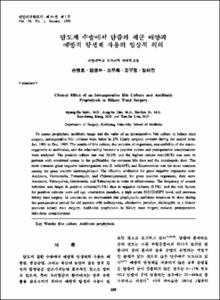담도계 수술에서 담즙의 세균 배양과 예방적 항생제 사용의 임상적 의의
- Keimyung Author(s)
- Kang, Koo Jeong; Lim, Tae Jin
- Department
- Dept. of Surgery (외과학)
- Journal Title
- 대한외과학회지
- Issued Date
- 1998
- Volume
- 54
- Issue
- 1
- Abstract
- To assess prophylatic antibiotic usage and the value of an intraoperative bile culture in biliary tract surgery, intraoperative bile cultures were taken in 276 biliary surgical patients during the period from Jan. 1991 to Dec, 1995. The results of bile culture, the isolation of organisms, susceptibility of the microorganisms to antibiotics, and the relationship between a positive culture and postoperative complications were analyzed. The positive culture rate was 56.5%, and the highest culture rate(100%) was seen in patients with combined stones in the gallbladder, the common bile duct and the intrahepatic duct. Hie most common gram negative microorganism was E. coli(44%), and Enterococcus was the most common among the gram positive microorganisms. The effective antibiotics for gram negative organisms were Amikacin, Gentamicin, Tobramycin, and Chloramphenicol; for gram positive organisms, they were Amikacin’ Tetracycline, Gentamicin, and Tobramycin in order of effectiveness. The frequency of wound infection was larger in positive cultures(11.5%) than in negative cultures (2.5%), and the risk factors for positive cultures were old age, obstructive jaundice, a high serum SGOT/SGPT level, and previous biliary tract surgery. In conclusion,we recommend that prophylactic antibiotic treatment be done during the perioperative period for old patients with leukocytosis, obstructive jaundice, cholangitis, or a history previous biliary tract surgery. Antibiotic prophylaxis in biliary tract surgery reduces postoperative infectious complications.
- Alternative Title
- Clinical Effect of an Intraoperative Bile Culture and Antibiotic Prophylaxis in Biliary Tract Surgery
- Publisher
- School of Medicine
- Citation
- 손병호 et al. (1998). 담도계 수술에서 담즙의 세균 배양과 예방적 항생제 사용의 임상적 의의. 대한외과학회지, 54(1), 109–116.
- Type
- Article
- ISSN
- 1226-0058
- Appears in Collections:
- 1. School of Medicine (의과대학) > Dept. of Surgery (외과학)
- 파일 목록
-
-
Download
 oak-bbb-02908.pdf
기타 데이터 / 396.57 kB / Adobe PDF
oak-bbb-02908.pdf
기타 데이터 / 396.57 kB / Adobe PDF
-
Items in Repository are protected by copyright, with all rights reserved, unless otherwise indicated.